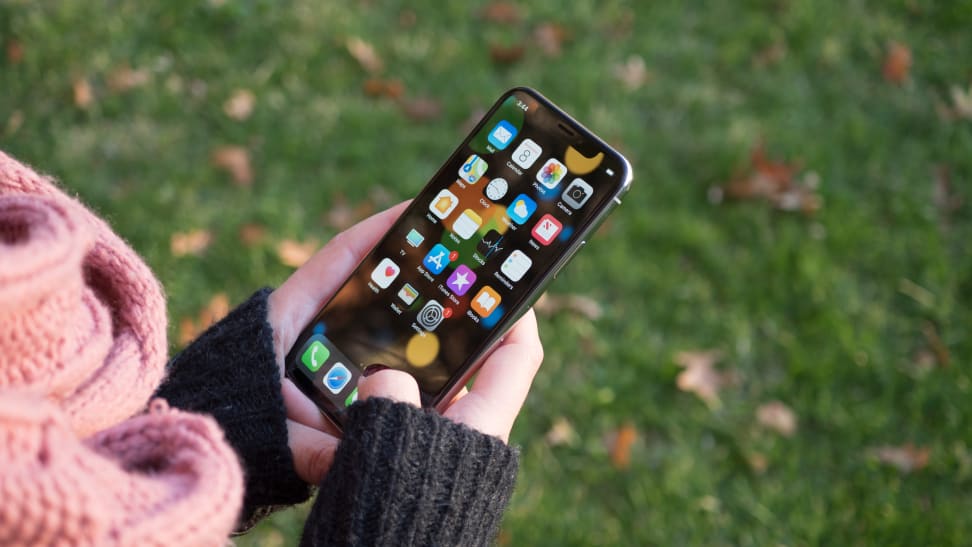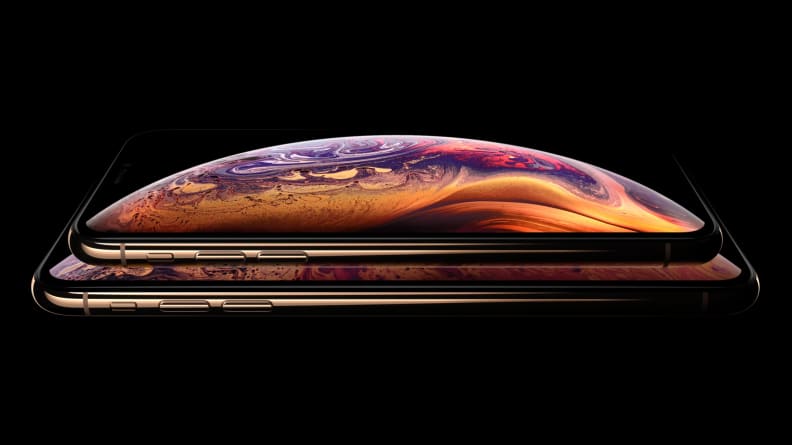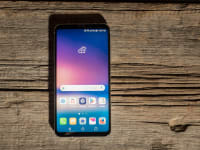 Credit:
Reviewed.com / Michael Desjardin
Credit:
Reviewed.com / Michael Desjardin
Products are chosen independently by our editors. Purchases made through our links may earn us a commission.
Well folks, it's iPhone season, and you know what that means: weeks of hand-wringing as we wait to see if our FOMO (fear of missing out) overtakes our SOFO (sense of financial obligation).
For most iPhone users, the newest models are intrinsically tantalizing—I should know, I've been an iPhone user for several years.
But if you're not enrolled in Apple's upgrade program, the choice to buy in can be a tough one. It often comes down to three factors: your lifestyle, how the newest iPhone compares to your current one, and how much money you're willing to shell out.
As Reviewed's resident "person who knows way too much about smartphones," I'd like to think I'm in a pretty good position to help you navigate Apple's new lineup.
So let's take a look at the three new iPhones—the iPhone XS, the iPhone XS Max, and the iPhone XR—and get to the bottom of which of these shiny new toys (if any) is the right one for you.
Should I buy the iPhone XS?

The iPhone XS is a slightly upscaled version of 2017's iPhone X. It offers a handful of modest hardware upgrades that are likely to entice those who seek the newest and best but elude folks who've grown accustomed to the last year's flagship iPhone:
The iPhone XS is powered by Apple's new A12 Bionic chipset. Apple claims this makes for a 50% increase in graphics performance and a 15% raise in its overall peak performance when compared to last year's iPhone X.
The iPhone XS is strapped with 4GB of RAM—a significant increase from the 3GB found under the hood of the iPhone X.
Though quite similar to the iPhone X's dual camera rig on paper, the sensors on the iPhone XS feature a larger pixel size. This means you can reasonably expect the iPhone XS to snap better photos in low-light settings.
The iPhone XS's image processing software also promises better contrast in the form of Apple's "Smart HDR" feature, which imitates a process we've seen Google use to overwhelming success on its line of Pixel smartphones.
At 2,658mAh, the iPhone XS's battery is of a slightly lower capacity than the iPhone X, whose battery clocks in at 2,716mAh. That said, I don't expect the iPhone XS's battery life to be significantly worse than its predecessor.
The iPhone XS's water and dust protection rating has seen a slight improvement over previous water-resistant iPhones. This year's models feature a rating of IP68, which means the iPhone XS can withstand a short amount of time submerged in up to three meters of water.
The iPhone XS features dual SIM slots. Although one of the SIM options is an electronically embedded SIM card, this feature is a game-changer for iPhone users who frequently travel or users with multiple numbers.
The iPhone XS is available with 512GB of storage, which is the largest amount of internal storage ever on an iPhone. It's also available in 64GB and 256GB variants.
There are a lot of nitty gritty upgrades here, but in almost every other way that matters to consumers, the iPhone XS is more or less the same phone as last year's iPhone X—right down to the near-identical physical dimensions and weight.
In fact, I'd wager there's a chance that the people graduating from an iPhone X to an iPhone XS won't even notice some of the most significant differences between the two.
That said, it is the newest iPhone, which makes it one of the best (and prettiest) phones money can buy. It all depends on how your current phone is holding up and how much cash you're willing to drop. If your relatively-new iPhone X or iPhone 8 is still chugging along with aplomb, you might want to hold out until next year.
Buy the iPhone XS if:
- You own an iPhone 7 or older and you're in need of an upgrade.
- Top-of-the-line performance is more important to you than saving money by skipping a generation.
- You love the idea of having a phone with 512GB of internal storage.
Don't buy the iPhone XS if:
- You own and enjoy an iPhone X or an iPhone 8 and it's not yet showing signs of age.
- You're intrigued by the entry-level iPhone XR (or a newly-discounted iPhone X or iPhone 8).
Should I buy the iPhone XS Max?

The most notable thing about the XS Max is its 6.5-inch display, which makes it the biggest iPhone ever. If you're worried about the size, fear not: The screen's edge-to-edge design allows for the phone's footprint to be roughly the same as the iPhone 8 Plus.
From a hardware standpoint, this is more or less the same phone as the iPhone XS, just a heck of a lot bigger. Here's some things to keep in mind:
Apple claims that the iPhone XS Max's OLED display—which has a resolution of 2,688 x 1,242 pixels—is capable of up to 60% higher dynamic range than its predecessor. This, coupled with its gigantic, 6.5-inch size, gives it arguably the best iPhone display to date.
The iPhone XS Max features a high-capacity battery that clocks in at 3,174mAh. Given the size of its screen, you can expect the XS Max to ride its battery pretty hard, but Apple's got a pretty good track record when it comes to squeezing battery life out of its big-screened iPhones, too.
It's not exactly a secret, but the iPhone XS Max doesn't come cheap. A maxed-out iPhone XS Max (512GB) will set you back $1,449. This is $100 more than a 512GB iPhone XS and $350 more than a 64GB iPhone XS Max.
For most people, the crown jewel of this year's iPhone launch is the standard-sized iPhone XS.
The way I see it, the beefed-up XS Max is for two types of iPhone shoppers: people who want a big screen and full-time phone users looking for the best battery life. If one or both of those things describes you, the iPhone XS Max is probably more your speed.
That said, if you're still enjoying an iPhone 8 Plus with less than a year of mileage under it's belt, dumping a pile of money on an upgrade to a premium phone might prove to be a preemptive play.
Buy the iPhone XS Max if:
- You own an iPhone 7 Plus or older and you're in need of an upgrade.
- You want the biggest screen possible.
- You want the best battery life possible.
Don't buy the iPhone XS Max if:
- You own and enjoy an iPhone X or an iPhone 8 Plus and it's not yet showing signs of age.
- You're intrigued by the entry-level iPhone XR (or a newly-discounted iPhone X or iPhone 8 Plus).
Should I buy the iPhone XR?

The most intriguing iPhone to come down the pike this year will be arriving fashionably late when it hits shelves at the end of October.
The iPhone XR—with its playful color variants and relatively modest hardware—is a spiritual successor to entry-level iPhones of the past, like 2013's iPhone 5c and 2016's iPhone SE.
But while the iPhone SE was a $400, entry-level iPhone in a world of $800 flagships, the iPhone XR is a $750, entry-level iPhone in a world of $1,000 flagships.
The XR's display and camera are the two biggest differences between the XR and the XS; you won't be getting the dual-camera set-up and the high-end OLED screen if you opt for the more affordable iPhone XR. You should also keep a few points in mind:
Despite its entry-level status, the iPhone XR is not the smallest of the three new iPhones—the iPhone XS is slightly smaller. For some people, one of the selling points of the entry-level iPhone SE was its deliberately small size. With the iPhone XR, Apple doesn't seem to be concerned with appeasing the crowd that prefers a smaller phone experience.
The iPhone XR features an LCD display. The 6.1-inch screen (828 x 1792) shares the same physical design as the edge-to-edge displays on the iPhone XS and XS Max—right down to the infamous notch at the top of the device—but you won't enjoy the deeper black levels and richer colors that OLED displays are capable of.
Shutterbugs, take note: You won't find a second, wide-angle camera on the iPhone XR. What you will find, however, is a single 12MP sensor with a version of Portrait mode comparable to the one found on the XS and XS Max. This means that you'll still be able to adjust photos to achieve a soft Bokeh effect, but you won't be getting the wide-angle lens and optical zoom found in the flagship iPhones.
Although the iPhone XS and XS Max clear the IP68 water resistance benchmark, the iPhone XR's water resistance rating, IP67, is comparable to last year's iPhones. This means that it's only safe for up to one meter of submersion for about thirty minutes—still nice to have, but not as robust as its higher-end siblings.
The iPhone XR is available in six different colors: black, white yellow, red, blue, and coral.
For the first time since its inception, Apple's 3D Touch was left off an iPhone. The iPhone XR doesn't feature 3D Touch, so any of the feature's (admittedly limited) functionality will be absent.
People hoping to see the XR receive the same treatment as the new, high-capacity 512GB iPhone XS models will have to settle for less: The highest capacity iPhone XR is a 256GB variant, and it retails for $899. You can also buy the iPhone XR in a 128GB model ($799) and a 64GB model ($749).
Despite its hardware concessions, I still believe the iPhone XR to be the best option for most people. The $750-$900 price tag isn't exactly cheap, but for most iPhone users, the missing features (OLED tech, a second primary camera, 3D Touch) won't be pain points.
Folks who were hoping that this year's entry-level iPhone would take on a smaller, more iPhone SE-like design might find the XR's size to be too big for its britches, but if you're already using an iPhone 7 or 8, the XR won't feel too big in your britches.
Here's the bottom line: The iPhone XR is a great choice for people with an iPhone 7 or older, especially the ones who are hesitant about shelling out cash for an iPhone XS. If you already use an iPhone 8, there's no reason to make the jump to the XR unless the edge-to-edge display, Face ID, or the new color variants are important to you.
Buy the iPhone XR if:
- You have an iPhone 7 or older and you're in need of an upgrade.
- You have an iPhone 8 and you want something a bigger screen, Face ID, and/or a more colorful design.
Don't buy the iPhone XR if:
- An OLED display and its many benefits are important to you.
- You want the flexibility of dual cameras.
- You own an iPhone 8 and you're perfectly happy with it.
- You own an iPhone X.


